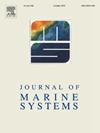Bottom-water hypoxia in the Paracas Bay (Peru, 13.8°S) associated with seasonal and synoptic time scale variability of winds and water stratification
Abstract
Coastal hypoxia can occur naturally in inshore areas of the Eastern Boundary Upwelling Systems, influenced by the nutrient-rich and low-oxygen upwelling waters. This study aims to explore the influence of water stratification and winds on bottom-water hypoxia of the Paracas Bay, an area subjected to the most intense alongshore winds and active coastal upwelling in the Peruvian coast. Monitoring data of the Pisco-Paracas water properties (dissolved oxygen, temperature, salinity and estimated stratification), the Pisco River flow, and the intensities of surface winds of the outside upwelling area, and of the local area, were analysed for the period 2006 to 2015. Bottom waters deeper than 8 m in the bay were shown undergoing a hypoxic regime (oxygen <1.4 mL L−1) that becomes more frequent towards austral summer and less frequent towards winter. This seasonal difference was associated with changes in the oxygen content of incoming upwelling waters and changes in the intensity of both local and upwelling winds that drive the hydrodynamics of the bay. High frequency data analysis revealed that synoptic time-scale fluctuations of the upwelling-favourable and local winds modulate the intra-seasonal variability of hypoxia. Fluctuations of the former drive the inshore expansion of mixed and less hypoxic upwelling waters during June–September, whereas fluctuations of the latter during December–April drive the entrance and circulation of more hypoxic upwelling waters, and the development of stratification events that contribute to the persistence of bottom hypoxia.

 求助内容:
求助内容: 应助结果提醒方式:
应助结果提醒方式:


